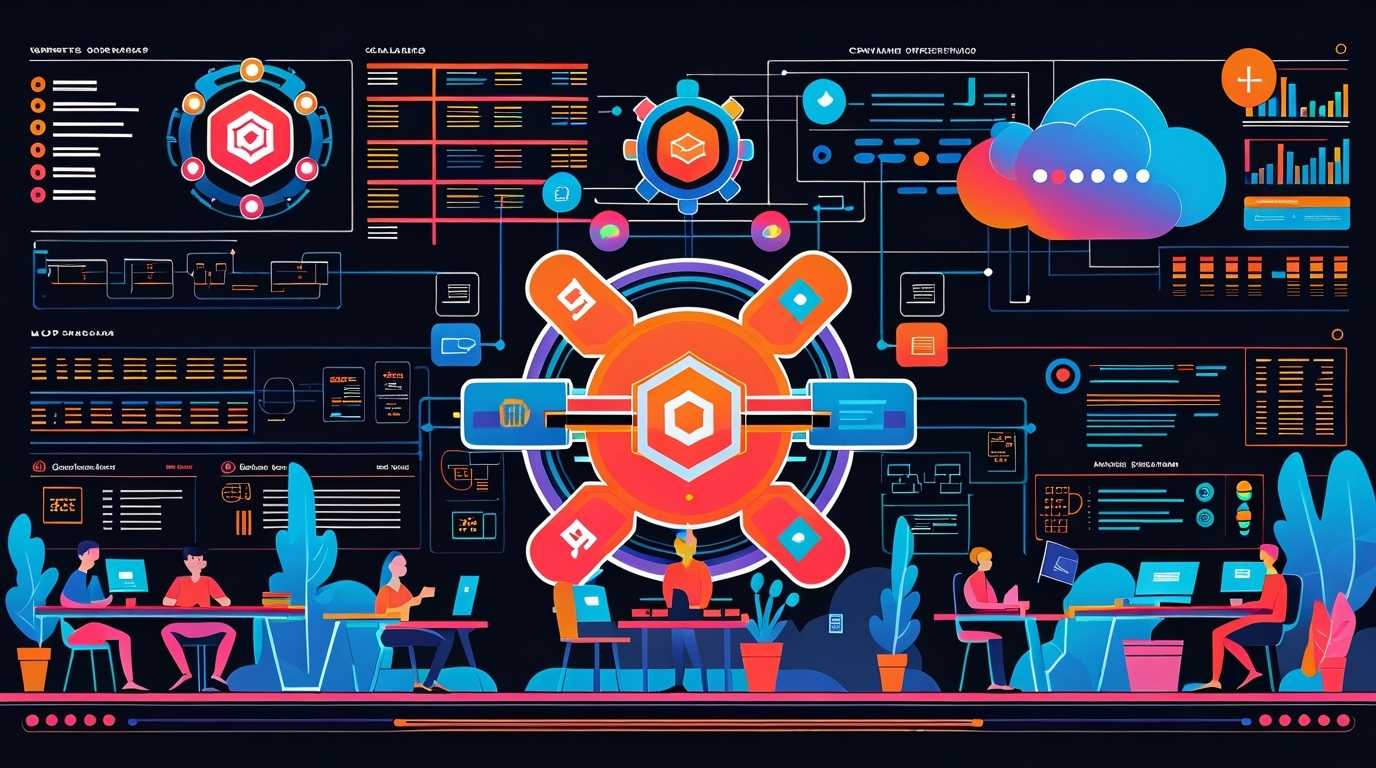Are you drowning in a sea of containers, struggling to manage them effectively? If you’ve ever wondered how to streamline your container deployment process, you’re not alone. In the world of container orchestration, choosing between Docker and Kubernetes can be daunting. This guide on Docker vs Kubernetes will clarify the key differences and help you harness the full potential of your containers.
What is Container Orchestration?
Container orchestration refers to the automated management of containerized applications, including their deployment, scaling, and networking. As organizations increasingly shift towards microservices architectures, managing individual containers at scale can become complex. Container orchestration simplifies this challenge, allowing developers to focus on application logic rather than infrastructure management.
The significance of container orchestration lies in its ability to streamline workflows, improve resource utilization, and enhance application availability. With tools like Docker and Kubernetes, organizations can manage microservices in a more efficient manner, reducing overhead and achieving faster deployment times.
Benefits of using container orchestration include:
- Automated Scaling: Dynamically adjusting the number of active containers based on demand.
- Load Balancing: Efficiently distributing network traffic to keep applications responsive.
- Self-Healing: Automatically restarting or replacing unhealthy containers.
- Configuration Management: Maintaining consistency across various environments.
In summary, container orchestration is fundamental for modern application deployment, ensuring that resources are used wisely and that applications are resilient and scalable.
Overview of Docker
Docker is an open-source platform that facilitates the creation, deployment, and management of containers. At its core, Docker leverages container technology to package applications with their dependencies into standardized units known as containers. This approach allows developers to create, test, and deploy applications quickly and consistently regardless of the underlying environment.
Key Components of Docker:
- Docker Engine: The runtime that enables users to build and run containers.
- Docker Hub: A repository for sharing and managing container images, simplifying the distribution of software applications.
- Docker Compose: A tool for defining and running multi-container applications through a single YAML file, allowing developers to manage complex environments effortlessly.
Docker’s architecture is designed with simplicity in mind, making it accessible for developers who want to containerize their applications without the overhead of configuring extensive orchestration tools. For instance, utilizing Docker for local development significantly speeds up the process, allowing for quick iterations and testing.
In essence, Docker focuses on the creation and management of individual containers, making it an invaluable tool for developers seeking to embrace containerization without the complexity of orchestration from the get-go.
Overview of Kubernetes
Kubernetes, often referred to as K8s, is a powerful container orchestration platform initially developed by Google. It provides a robust framework for running distributed systems resiliently. Kubernetes automates deployment, scaling, and operation of application containers across clusters of hosts, allowing you to manage containerized applications with greater efficiency and flexibility.
Core Features of Kubernetes:
- Automated Scaling: Kubernetes can automatically scale your applications up or down based on demand, ensuring optimal resource utilization.
- Robust Networking: K8s provides a sophisticated networking model, including service discovery and load balancing, to facilitate communication between containers.
- Storage Orchestration: Kubernetes can automatically mount the storage system of your choice, whether it’s local storage, public cloud storage, or networked storage.
- Self-Healing Capabilities: It automatically restarts and replicates containers in the event of a failure, maintaining the application’s desired state.
Kubernetes employs a master-slave architecture, where a central master node manages a cluster of worker nodes. The master node schedules containers on available resources, ensuring that workloads can be distributed evenly while meeting performance and availability requirements.
By abstracting away infrastructure complexities, Kubernetes empowers organizations to deploy, manage, and scale applications across hybrid cloud environments with minimal friction. This level of orchestration is essential for businesses that require resilience, maintenance, and automated processes at scale.
Key Differences Between Docker and Kubernetes
While Docker and Kubernetes are often mentioned together, they serve different purposes within the container ecosystem. Understanding their differences is crucial for selecting the right solution for your needs.
Deployment Models
- Docker focuses on the individual container and its lifecycle. It’s primarily suited for building and running containerized applications.
- Kubernetes, on the other hand, operates at a higher level, managing many containerized applications across a cluster of machines. It offers features for deploying, scaling, and managing container applications.
Scalability Options
- Docker supports container scaling but requires manual configuration or additional tools to handle scalability effectively. As you scale, managing numerous individual containers can become cumbersome.
- Kubernetes excels in scalability with its built-in features, allowing for automatic scaling based on traffic, resource utilization, or custom metrics.
Resource Management
- Docker provides some resource management tools but lacks advanced features like metrics-driven autoscaling, resource quotas, and limits, which can help optimize resource usage.
- In contrast, Kubernetes offers robust resource management capabilities, providing insights and controls that help ensure efficient resource utilization across all containers.
Ecosystem and Integrations
- The Docker ecosystem includes various tools, such as Docker Compose, which certainly enhance container management but might require supplementary tools for orchestration.
- Kubernetes has developed a rich ecosystem of APIs, services, and tooling, enabling deeper integrations with CI/CD systems, monitoring tools, and cloud services, all of which support automated workflows.
When to Use Docker vs Kubernetes
Determining when to use Docker versus Kubernetes depends on the complexity of your applications and your team’s operational needs.
If your requirements are straightforward — such as developing, testing, or deploying a small application — Docker is likely the most efficient choice. Its simplicity and ease of use allow developers to quickly get started with containerization without the overhead of complex orchestration features. Docker is also great for individual developers who want to containerize their applications for local development.
Conversely, if your organization is looking to scale applications across multiple environments or you need to manage a microservices architecture, Kubernetes becomes essential. It is designed for managing complex workloads, performing continuous deployment, and providing self-healing capabilities to enhance resiliency.
Some scenarios to consider:
- Choose Docker for isolated container development and testing environments or small-scale applications where orchestration is unnecessary.
- Choose Kubernetes when managing multiple services with high availability and scalability demands, like e-commerce platforms or large web applications.
Ultimately, Docker and Kubernetes can also complement each other. Start with Docker for local development and testing and transition to Kubernetes for production environments to leverage the strengths of both tools.
Conclusion
In summary, understanding Docker vs Kubernetes is essential for any organization looking to effectively manage containerized applications. Both tools serve unique purposes, but with the right knowledge, you can leverage them to maximize efficiency.
Docker provides a straightforward solution for creating and managing individual containers, while Kubernetes excels in orchestrating complex, distributed applications. Adopting the right strategy for your development process is key to enhancing productivity and performance. For expert guidance on container orchestration, trust WildnetEdge to lead the way.
FAQs
Q1: What is the main purpose of Docker in container orchestration?
Docker is primarily used for creating and managing individual containers, making it easier to develop, ship, and run applications.
Q2: How does Kubernetes improve application deployment?
Kubernetes automates deployment, scaling, and management of containerized applications, enabling efficient resource use.
Q3: Can Docker and Kubernetes be used together?
Yes, Docker serves as the container engine while Kubernetes orchestrates the management of those containers at scale.
Q4: What are some common challenges when using Docker for orchestration?
Docker can struggle with scaling and managing multiple containers, which is where Kubernetes excels.
Q5: Are there specific industries where Kubernetes is more beneficial?
Kubernetes is widely adopted in industries requiring rapid scaling and high availability, such as tech and e-commerce.

Nitin Agarwal is a veteran in custom software development. He is fascinated by how software can turn ideas into real-world solutions. With extensive experience designing scalable and efficient systems, he focuses on creating software that delivers tangible results. Nitin enjoys exploring emerging technologies, taking on challenging projects, and mentoring teams to bring ideas to life. He believes that good software is not just about code; it’s about understanding problems and creating value for users. For him, great software combines thoughtful design, clever engineering, and a clear understanding of the problems it’s meant to solve.
 sales@wildnetedge.com
sales@wildnetedge.com +1 (212) 901 8616
+1 (212) 901 8616 +1 (437) 225-7733
+1 (437) 225-7733































